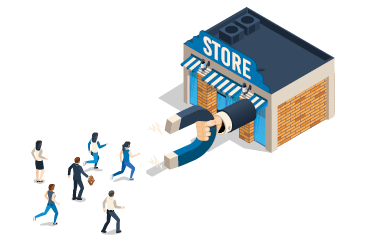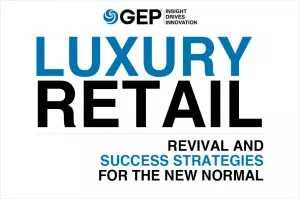The pandemic and recessionary pressures have rattled luxury retail.
And with consumers avoiding non-essential spend, there’s no respite in sight.
What can luxury retailers do to preserve cash, optimize costs, and win back customers?
A new, timely GEP white paper — Luxury Retail: Revival and Success Strategies for the New Normal — examines the challenges luxury brands are facing right now and what they can do to minimize the impact of the current slowdown.
It also shares specific procurement and supply chain strategies to help them cope effectively with the disruption.
What’s Inside:
- Getting ready for the holiday season — stores, labor, operations
- New priorities for 2021 and beyond
- Developing online and omnichannel capabilities
A must-read for procurement, supply chain and business leaders looking to help their enterprises thrive in the new normal.
After over a decade of economic boom, which saw the rise of an affluent class of Chinese shoppers, the COVID-19 pandemic and the global economic slowdown have cast a deep, dark shadow on luxury retail. The uncertainty around the resolution of the pandemic has dimmed the outlook for luxury retail for the next few years.
The time to act is now, and luxury retailers will need to shift gears and define new business priorities. Ultimately, success will depend on the ability to make tough choices that don’t damage brand strength and identity.
In this paper, GEP’s retail experts have identified opportunity areas where business leaders can take immediate action to minimize the impact of the recessionary environment without losing sight of the long-term luxury value proposition.

BOLD, DECISIVE ACTIONS ARE NEEDED PRIOR TO THE HOLIDAY SEASON
In the short term, luxury retailers will need to take steps that will help them make the most of holiday buying, as well as set the stage for longer-term shifts in strategy
MAKE LIQUIDITY MANAGEMENT A PRIORITY
The pandemic-related shutdowns and ongoing restrictions on store openings mean there will be less revenue available for luxury retailers. So, it is imperative to optimize working capital to ensure that cash is available to exploit upcoming opportunities.
Historically, luxury retailers have been reluctant to pursue the more aggressive cash flow practices that have become popular with retail and CPG industries. Many of these companies have successfully extended payment terms with non-core vendors to 120 days or more, enabling them to free up significant working capital. This is one of the easier strategies that luxury retailers can execute.
HAVE A GAME PLAN FOR STORE LABOR AND STORE OPERATIONS
As we near the holiday season, there remains substantial uncertainty. How will store employees feel about going to the store, interacting with customers and offering top-tier customer service? Will consumers have a stress-free shopping experience? Is luxury shopping worth the risk in a pandemic environment?

The reality is, there are no clear answers right now. Further complicating matters, the answers will probably be very different region by region — and will change in unexpected ways over time.
Luxury retailers must prepare a game plan in advance to address the most likely scenarios to stabilize store operations. They should have a flexible plan that will allow them to adapt to rapidly shifting factors.
Government regulations loom prominently, so keep a close watch on fast-changing laws and restrictions. New in-store prevention and safety protocols have become mandatory requirements for both employees and other store labor in most regions. But it goes beyond wearing masks and providing sanitization. The layout of a store also needs to be re-imagined to ensure customers are safe and feel confident while shopping.
TOUGH DECISIONS ON DISCOUNTING: WILL YOU OR WON’T YOU?
Discounting has always been a sensitive issue for luxury retailers. Discounting can impact the long-term strength of a brand. It has even prompted some very well-known brands to go as far as destroying excess stock rather than eroding their pricing premium. It is a long-held belief that consistent pricing reinforces the relationship with customers and increases a luxury brand’s value proposition.
However, the major, unprecedented drop in demand and sales1 has reopened the debate on discounting. What’s important here is to form your brand strategy prior to sales performance, so that you avoid holding too many products at the wrong time. Rather than a one-time COVID-19 sale, luxury retailers will likely be better off pursuing lower-profile discount strategies such as:
- Private Sales: Special rates can be offered non-publicly to high-value customers, so the discount benefits only customers who have been successful for the retailer.
- Inventory Management: Reallocate existing stock across regions and channels to privileged geographic markets that are less affected by the pandemic, and make sure to fulfill online orders. Leverage the returns infrastructure already in place.
- Outlet Store Channels: For retailers that already have this infrastructure, this channel can be a solution to the increased stock than what would have flowed to it in the normal run.
RESET THE COST STRUCTURE
Many luxury retailers have already taken steps to manage their Selling, General and Administrative (SG&A) costs through budget actions led by the finance team. Some of these are easy to implement: A travel restriction or ban is easy to explain. A hiring freeze can make sense as recession looms.
But while immediate cost-cutting initiatives will provide short-term results, companies will find that they are not sustainable. A comprehensive cost reduction program should be deployed across all non-payroll spend. Lowering administrative expenses through a C-suite-sponsored strategic sourcing program can rapidly reduce costs and position the business to take advantage of sustained cost benefits.
NEW PRIORITIES FOR 2021 AND BEYOND
Change is a given. As the dust settles and a ‘new normal’ emerges amid a global economic slowdown, luxury retailers will have to evaluate and set priorities for the future.
DIGITAL TRANSFORMATION IS NOW A NECESSITY
The pandemic has accelerated retail’s digital transformation, perhaps irreversibly. There is strong evidence of this is in the surge of e-commerce penetration in the U.S. — which was growing rapidly even before the pandemic. E-commerce penetration crossed 25% in April 2020, up from 15% at the end of 2019,2 hastening several years of adoption.
So far, luxury retail has been reluctant to embrace real digital transformation. The segment has been hesitant to disrupt a formula that has worked well for them for decades. However, as the world changes, it is critical to ensure you change and adapt with it, in the right way. The key to connecting with your customers is to provide consistency in branding and customer experience through a digital-first approach.
Reimagine the Customer Experience Via Talent and a Flexible ‘In-Store’ Reality
Remember, digital transformation is about more than just technology. The first step is to assess the current talent pool and identify where employees can serve as champions of change. This will help increase the speed at which you can transition into the new way of working.3
A key evolution for this new environment will be establishing an in-store customer experience that is safe and convenient. Technology — from remote-working platforms to virtual showrooms — can help luxury companies maintain productivity during the crisis, and improve productivity for good. Elements such as virtual showrooms, digital prototyping and sampling will also be valuable in maintaining strong relationships with buyers, especially during times when there are travel restrictions.
Identify solutions that can easily be tested. They will pave the way for the shift from planning to action, and help determine which suppliers and systems will integrate most efficiently into your process.
Build Stronger Customer Experiences Through Technology Enablers
Digital investments will enable consistency in branding while improving usefulness by creating a reliable and safe experience for the consumer. The move to using and sharing real-time information over manual tracking, for example, offers substantial advantages — for luxury brands and consumers — without requiring creative or design process changes.
In the post-COVID-19 world, digital experiences — whether in-store or online — will become the accepted norm. Customers will expect luxury retailers to manage no-touch, physically distanced experiences. Not only because of safety, but because they are efficient.
While e-commerce spending has surged during the shutdown, the appetite for contactless in-store shopping has also intensified. Features such as free delivery and returns, mobile payments, mobile app orders and on-demand, instore product pickups are increasingly important for shoppers.
Luxury retailers should collaborate with suppliers, procurement, design, and IT to create market differentiation from these digital approaches. These solutions will help create a unified message across the organization. But most importantly, it will create loyalty for the consumer base because these experiences exceed the need for easy, simple, time-saving personalized shopping.
GO OMNICHANNEL

Purchases at luxury retail stores will continue to be the largest contributor to overall sales in any region. We anticipate, however, that there will be a massive surge in the use of online channels owing to the continuing pandemic crisis. What this means is that luxury retailers should develop omnichannel capabilities ahead of schedule. As the shift to digital buying progresses at an unprecedented pace, luxury brands need to model their distribution strategies to accommodate an increase in online demand.
While online purchases will grow at exponential rate compared to brick-and-mortar buying, customers will continue to spend the largest amounts in brand stores. Luxury retailers should continue investing in flagship stores to attract and lure customers, as they will likely remain at the heart of the customer’s journey.
The fashion industry is in the throes of retail hybridization.4 The key is to get the balance right and to ensure an integrated experience. Seamless integration between physical points of sale and online channels is the recipe for a successful long-term omnichannel strategy.
BUILD AGILITY INTO YOUR SUPPLY CHAIN

As the future remains unpredictable, brands must develop the ability to track, analyze, and act on demand trends. Digitalization and data analysis will be key to gathering information and allowing retailers to maintain the required inventory. Retailers will need to respond faster to shifting market conditions, reduce time to market, and decrease exposure to market volatility. Brands must reinvent their supply chain and renegotiate supplier relationships to build agility and flexibility into the supply chain.
Brands may need to make some tough calls and shift from their large manufacturing partners to multiple producers that operate regional factories located closer to distribution centers and offices. Cutting delivery times, improving time to market and lowering inventory are expected priorities in the near future.
An example of a modern supply chain is the Inditex logistics model. With over half of their manufacturing activity in proximity (Spain, Portugal, Turkey and Morocco) to their Spain-based distribution centers, they have several advantages including: more accurate forecasts, faster response times as customers’ preferences evolve, fewer inventory overstock situations and faster delivery times. This strategy makes their supply chain flexible and agile, giving them a competitive advantage.
Some brands should evaluate further vertical integration, particularly large companies that would benefit from acquiring manufacturing capacities to build competitive advantage. A case in point is Burberry’s acquisition of a leather goods manufacturer, now called Burberry Manifattura, based in Florence, which makes leather bags for Burberry’s market in Europe.
SUSTAINABILITY IS HERE TO STAY
Sustainability has become an important issue for consumers with the popularity of environmental causes and movements, such as the global effort to reduce the effects of climate change, energy consumption and pollution. Luxury brands are not immune to environmental criticism and reputational damage. In fact, in 2019, the UN Conference on Trade and Development reported on the adverse environmental effects of fast fashion and the clothing industry.
Luxury brands are aware and responding.
Change began in the summer of 2019 when 32 companies, including fast-fashion and luxury fashion brands (Burberry, Chanel, GAP, Mango, Nike, Nordstrom, Prada, Ralph Lauren, and more), signed the Fashion Pact at the G7 Summit.5 The agreement promises to combat global warming, restore biodiversity, protect the oceans and embrace sustainability. Without this action, the global fashion industry could account for a quarter of the world’s carbon budget by 2050.6
The Rise of Circular Fashion
Shoppers have started to shift from frivolous buying to wise investments. “We have seen our customers moving away from the easy ‘Insta-ready’ entry-level items to investment purchases, most notably in forever bags from brands like Gucci, Bottega Veneta and Saint Laurent,” Jess Christie, chief brand officer at Matchesfashion.com, was quoted saying in a recent interview.7
Also, second-hand fashion is forecast to climb in the coming years and overtake the fast-fashion market by 2029.8 Embracing second-hand initiatives would be a smart move for luxury retailers. For example, earlier this year, online luxury retail platform Farfetch announced its collaboration with Thrift+, an online marketplace and donation service for pre-owned clothes.
Your New ‘Woke’ Customer
Before the pandemic, luxury brands were already pivoting toward sustainability and socially conscious models. This approach is not expected to change, with successful luxury brands adhering to their sustainability goals as they look to attract younger, affluent buyers.
Millennials and Gen Z are more conscious of the environmental and social impacts of their purchase decisions, and are more likely to buy from a brand that resonates with their own personal values. These consumers drive 85% of the global luxury sales growth, and their expectation is that the luxury brands they choose be aligned with their values.
So, luxury brands that want to retain their hold and reputation must have a solid sustainability message even during an economic recession. A Nielsen study shows that 73% of millennial respondents are willing to pay extra for a product if it comes from a sustainable or socially conscious brand (up from 50% in 2014).9 That’s far more than what the older generations indicated.
A TWO-PHASED APPROACH TO SUCCESS
The traditional strengths of luxury retailers are not working to their advantage in the current situation. As demand drops and consumers spend less, leaders at luxury fashion houses should be bold in their thinking. They need to redefine strategies and take definitive steps so that they are better equipped — technologically and culturally — to navigate the current economic situation successfully. Business leaders should execute a two-phase plan: Design rapid plans to be ready for holiday season opportunities, and develop longer-term strategies that allow you to emerge leaner, cost-focused and digitally transformed in the new normal.
- “Pandemic Continues to Dull Allure Of Luxury Goods” Pyments.com, 1 July 2020. Retrieved 5 October 2020 from https://www.pymnts.com/news/retail/2020/pandemic-continues-to-dull-allure-of-luxury-goods/
- “COVID-19 Special Report #6: Accelerated Retail Evolution Could Bolster Demand for Well-Located Logistics Space,” Prologis, Inc., June 2020.Retrieved 5 October 2020 from https://www.prologis.com/logistics-industry-research/covid-19-special-report-6-accelerated-retail-evolution-could-bolster
- “Digital Procurement Maturity: Getting Top Value From Technology and Talent,” GEP, 18 March 2016. Retrieved 5 October 2020 from https://www.gep.com/research-reports/digital-procurement-maturity
- Jeroma Monange, “Omnichannel Is Reinventing Physical,” Lab Luxury and Retail, 9 November 2018. Retrieved 5 October 2020 from https://labluxuryandretail.paris/omnichanel-is-reinventing-physical/
- “The Fashion Pact,” 22 August 2019. Retrieved 5 October 2020 from https://thefashionpact.org/?lang=en
- Sandra Laville, “Stella McCartney Calls for Overhaul of ‘Incredibly Wasteful’ Fashion Industry,” The Guardian, 28 November 2017. Retrieved 5 October 2020 from https://www.theguardian.com/environment/2017/nov/28/stella-mccartney-calls-for-overhaul-of-incredibly-wasteful-fashion-industry
- Jessica Davies, “How Are Luxury Retailers Taking On Sustainability?” Harper’s Bazaar, 2 January 2020. Retrieved 5 October 2020 from https://www.harpersbazaar.com/uk/fashion/fashion-news/a29386990/luxury-retailers-sustainability
- Huw Hughes, “UK Shoppers’ Interest in Second-Hand Fashion Continues to Grow,” FashionUnited, 26 March 2019. Retrieved 5 October 2020 from https://fashionunited.uk/news/fashion/uk-shoppers-interest-in-second-hand-fashion-continues-to-grow/2019032642384
- “Consumer-Goods’ Brands That Demonstrate Commitment to Sustainability Outperform Those That Don’t,” 2015 Nielsen Global Corporate Sustainability Report, Nielsen, 12 October 2015. Retrieved 5 October 2020 from https://www.nielsen.com/wp-content/uploads/sites/3/2019/04/Global20Sustainability20Report_October202015.pdf



